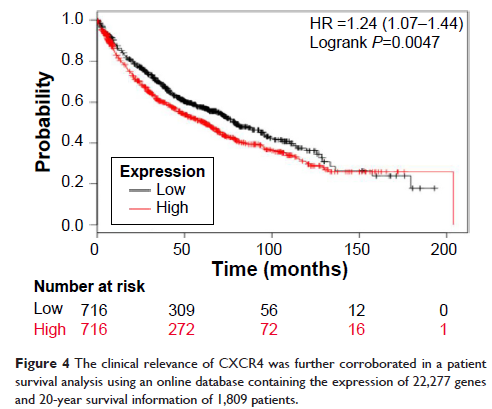109669
论文已发表
注册即可获取德孚的最新动态
IF 收录期刊
- 3.4 Breast Cancer (Dove Med Press)
- 3.2 Clin Epidemiol
- 2.6 Cancer Manag Res
- 2.9 Infect Drug Resist
- 3.7 Clin Interv Aging
- 5.1 Drug Des Dev Ther
- 3.1 Int J Chronic Obstr
- 6.6 Int J Nanomed
- 2.6 Int J Women's Health
- 2.9 Neuropsych Dis Treat
- 2.8 OncoTargets Ther
- 2.0 Patient Prefer Adher
- 2.2 Ther Clin Risk Manag
- 2.5 J Pain Res
- 3.0 Diabet Metab Synd Ob
- 3.2 Psychol Res Behav Ma
- 3.4 Nat Sci Sleep
- 1.8 Pharmgenomics Pers Med
- 2.0 Risk Manag Healthc Policy
- 4.1 J Inflamm Res
- 2.0 Int J Gen Med
- 3.4 J Hepatocell Carcinoma
- 3.0 J Asthma Allergy
- 2.2 Clin Cosmet Investig Dermatol
- 2.4 J Multidiscip Healthc

已发表论文
对 CXCR4 在非小细胞肺癌 (NSCLC) 治疗中作为预后指标和潜在的药物靶点的一项荟萃分析
Authors Zhang C, Li J, Han Y, Jiang J
Published Date June 2015 Volume 2015:9 Pages 3267—3278
DOI http://dx.doi.org/10.2147/DDDT.S81564
Received 25 January 2015, Accepted 14 April 2015, Published 24 June 2015
Approved for publication by Professor Shu-Feng Zhou
Background: Recent reports have shown that C-X-C chemokine receptor type 4 (CXCR4) is a candidate oncogene in several types of human tumors, including non-small cell lung cancer (NSCLC). However, the correlation between CXCR4 expression and clinicopathological characteristics of NSCLC remains controversial and has not been emphasized. The aim of this study is to quantitatively evaluate the association of CXCR4 expression with the incidence of NSCLC and clinicopathological characteristics by performing a meta-analysis.
Methods: A detailed literature search was carried out for related research publications. Only articles in which CXCR4 expression was detected by immunohistochemical staining were included. Odds ratio (OR) and hazard ratio (HR) with 95% confidence intervals (CIs) were calculated and summarized.
Results: Final analysis of 1,872 NSCLC patients from 19 eligible studies was performed. We observed that CXCR4 expression was significantly higher in NSCLC than in normal lung tissue, based on the pooled OR from ten studies, including 678 NSCLCs and 189 normal lung tissues (OR =16.66, 95% CI =6.94–40.02, P <0.00001). CXCR4 expression was also significantly associated with clinical stages, metastatic status, and overall survival (OS) in NSCLC patients. In addition, CXCR4 mRNA high expression was found to correlate with worse OS of all NSCLC patients followed for 20 years, HR =1.24, P =0.0047.
Conclusion: The present meta-analysis indicated that CXCR4 protein expression is associated with an increased risk and worse survival in NSCLC patients. The aberrant CXCR4 protein and mRNA expression play an important role in the carcinogenesis and metastasis of NSCLC.
Keywords: prognosis, meta-analysis, odds ratio, hazard ratio
Methods: A detailed literature search was carried out for related research publications. Only articles in which CXCR4 expression was detected by immunohistochemical staining were included. Odds ratio (OR) and hazard ratio (HR) with 95% confidence intervals (CIs) were calculated and summarized.
Results: Final analysis of 1,872 NSCLC patients from 19 eligible studies was performed. We observed that CXCR4 expression was significantly higher in NSCLC than in normal lung tissue, based on the pooled OR from ten studies, including 678 NSCLCs and 189 normal lung tissues (OR =16.66, 95% CI =6.94–40.02, P <0.00001). CXCR4 expression was also significantly associated with clinical stages, metastatic status, and overall survival (OS) in NSCLC patients. In addition, CXCR4 mRNA high expression was found to correlate with worse OS of all NSCLC patients followed for 20 years, HR =1.24, P =0.0047.
Conclusion: The present meta-analysis indicated that CXCR4 protein expression is associated with an increased risk and worse survival in NSCLC patients. The aberrant CXCR4 protein and mRNA expression play an important role in the carcinogenesis and metastasis of NSCLC.
Keywords: prognosis, meta-analysis, odds ratio, hazard ratio
